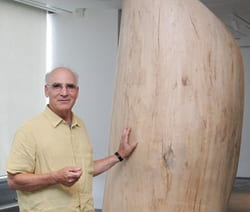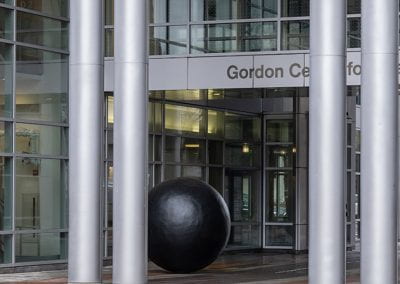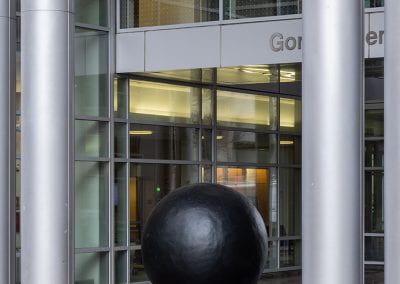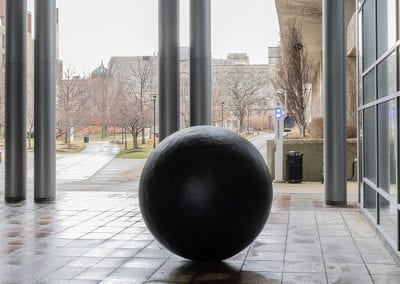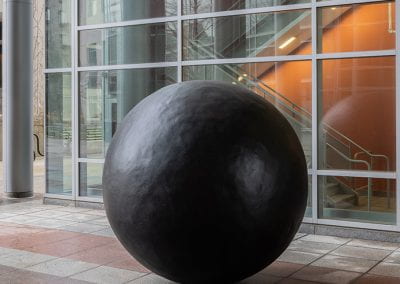Black Sphere
Jene Highstein (1942-2013)
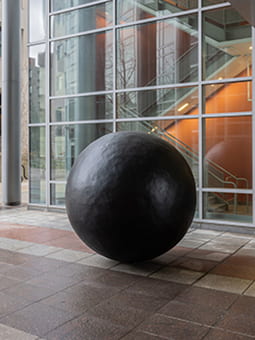
1976
Reconstructed by the artist 1985
Current installation 2022
Painted cement over steel structure
Height: 72 in. (182.9 cm)
Diameter: 76 in. (193 cm)
Located at Gordon Center for Integrative Science
929 E 57th St, Chicago, IL 60637
Donated to the University by Betsy and Andy Rosenfield in honor of Lindy and Edwin Bergman (former Chairman of the Board of Trustees)
“The density…generates an awareness of one’s own physical weight and mass in relation to the sculpture. Comprehending [Black Sphere] is an intuitive rather than deductive process—one of body empathy and movement through the space in response to the object.”
Michael Auping, “Jene Highstein/MATRIX 26”
Black Sphere is one of five black concrete sculptures created by Jene Highstein between 1975 and 1977, with a distinctly spherical shape that sets it apart from the other four mound-shaped works. Where the latter are firmly grounded, rising gradually from the plane upon which they rest, Black Sphere sits precariously, perched like a ball about to set in motion. Movement is more than merely formally invoked, as Black Sphere has traveled extensively from its initial installation at the Holly Solomon Gallery in New York in 1976, to its current siting on South Ellis Avenue in Chicago.
This is no mean feat for a 3,000-pound steel and concrete sculpture, whose industrial materials convey a density of mass that is only further accentuated by the opaque black surface of the sphere, stretching just over six feet in diameter. Despite the sense of solidity the sculpture imparts, its concrete surface is a mere skin. Constructed by the gradual application of concrete by hand to a mesh-covered, hollow steel armature, Highstein’s Black Sphere was achieved by a process of human approximation that is markedly different from the exacting industrial procedures of most Minimalist sculptors. It defies the formal expectations of regularity that its geometrically-derived shape invites. Although it suggests all the industrial might of large-scale construction, Black Sphere is far frailer than it appears, and its many moves have necessitated numerous restorative efforts that have materially transformed the sculpture.
Related Links
Black Sphere at The Renaissance Society, 1980
Conservator Amanda Trienens and gallerist Rhona Hoffman discuss the process and materials Jene Highstein used to create Black Sphere in an audio entry for Monochrome Multitudes at the Smart Museum of Art.
Video
Interview with Jene Highstein (STONE Project)
Archival Materials
Photograph of Black Sphere‘s original campus siting, 1980
Source: LUNA Library, UChicago Public Art Collection and Archive
Photograph of Jene Highstein and Black Sphere at the Holly Solomon gallery
Source: LUNA Library, UChicago Public Art Collection and Archive
Photograph of Black Sphere being transported via truck
Source: LUNA Library, UChicago Public Art Collection and Archive
Photograph of Black Sphere at MoMA, 1984
Source: LUNA Library, UChicago Public Art Collection and Archive
Brochure for the MATRIX/BERKELEY 26 exhibition
Source: University of California, Berkeley Art Museum
Sources
“Alanna Heiss and Jene Highstein, Parts 1 and 2.” The Clocktower Oral History Project. Clocktower. Part 1. Part 2.
Auping, Michael. “Jene Highstein: Black Sphere, 1976,” MATRIX/BERKELEY 26. Berkeley, CA: University Art Museum, August 1-October 31, 1979. Online.
Doe, Donald Bartlett, and Neubert, George W. “Jene Highstein: Shapes in the Stream.” Paper 39. Lincoln, NE: Sheldon Museum of Art Catalogues and Publications, 1985.
“Oral history interview with Susanne Ghez, 2011 Jan. 25-26.” Smithsonian Institution, Archives of American Art. Transcript.
Further Reading
Black Sphere object label (PDF) written by Peggy Mason, Professor, Department of Neurobiology, for Monochrome Multitudes at the Smart Museum of Art, 2022.
Rossi, Laura Mattioli. Lines in Space. Milan: Charta, 2008.
“The Artist in Place: The First Ten Years of MoMA PS1.” MoMA, 2012. Online.
Gallery
Click on the image to zoom in
Black Sphere outside of the Gordon Center for Integrative Science. Photo by Michael Tropea. (1 of 4)
Black Sphere outside of the Gordon Center for Integrative Science. Photo by Michael Tropea. (2 of 4)
Black Sphere outside of the Gordon Center for Integrative Science. Photo by Michael Tropea. (3 of 4)

